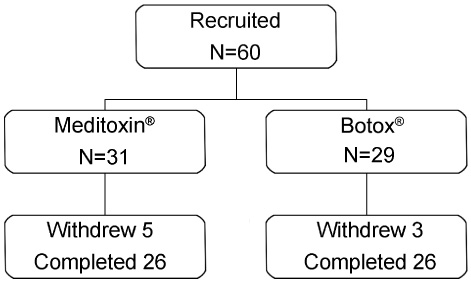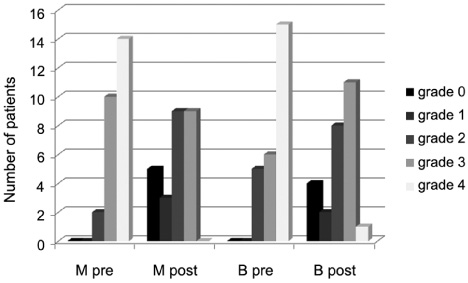Korean J Ophthalmol.
2009 Sep;23(3):137-141. 10.3341/kjo.2009.23.3.137.
Double-Blind, Randomized, Comparative Study of Meditoxin(R) Versus Botox(R) in the Treatment of Essential Blepharospasm
- Affiliations
-
- 1Department of Ophthalmology, Institute of Vision Research, University of Yonsei, Seoul, Korea. sylee@yuhs.ac
- 2Department of Ophthalmology, University of Chung-Ang, Seoul, Korea.
- KMID: 1115742
- DOI: http://doi.org/10.3341/kjo.2009.23.3.137
Abstract
- PURPOSE
To compare the efficacies and safeties of Meditoxin(R) (Medy-Tox, Korea) and Botox(R) in the treatment of essential blepharospasm. METHODS: We performed a double-blind, randomized, comparative trial comparing Meditoxin(R) and Botox(R) for treatment of blepharospasm in 60 patients from the intention-to-treat (ITT) population and 52 patients from the per-protocol (PP) population. We analyzed the improvements in severity of spasm (SS) at four weeks post-injection as a primary efficacy outcome. Changes in eyelid closing force (CF) and functional visual status (FVS) after injection were analyzed for secondary efficacy outcomes, and adverse effects were demonstrated for the safety evaluation. RESULTS: Improvement in SS was noted in 90.3% of the Meditoxin(R) group and 86.2% of the Botox(R) group. There were no significant differences between treatment groups in the changes of CF and FVS post-injection (p>0.05). Since the lower limit of the 95% confidence interval (-1.76% for ITT, -1.64% for PP) was over the -15% threshold, we determined that Meditoxin(R) was not inferior to Botox(R) in either the ITT or PP populations. Adverse effects developed in 16.1% of the Meditoxin(R) group and 27.6% of the Botox(R) group, but no serious adverse events were found in either group. CONCLUSIONS: Meditoxin(R) and Botox(R) were comparable in efficacy and safety in the treatment of essential blepharospasm.
Keyword
MeSH Terms
Figure
Cited by 2 articles
-
Long-term Efficacy of Botulinum Neurotoxin-A Treatment for Essential Blepharospasm
Seunghyun Lee, Sangrye Park, Helen Lew
Korean J Ophthalmol. 2018;32(1):1-7. doi: 10.3341/kjo.2017.0030.Comparison of Safety and Efficacy of Botox and Neuronox in the Management of Benign Essential Blepharospasm: A Split-face Study
Sayali Sane, Mohammad Javed Ali, Milind N Naik
Korean J Ophthalmol. 2019;33(5):430-435. doi: 10.3341/kjo.2016.0123.
Reference
-
1. Scott AB, Kennedy RA, Stubbs HA. Botulinum A toxin injection as a treatment for blepharospasm. Arch Ophthalmol. 1985. 103:347–350.2. Jankovic J, Orman J. Botulinum A toxin for cranial-cervical dystonia: a double-blind, placebo-controlled study. Neurology. 1987. 37:616–623.3. Taylor JD, Kraft SP, Kazdan MS, et al. Treatment of blepharospasm and hemifacial spasm with botulinum A toxin: a Canadian multicentre study. Can J Ophthalmol. 1991. 26:133–138.4. Park YC, Lim JK, Lee DK, Yi SD. Botulinum a toxin treatment of hemifacial spasm and blepharospasm. J Korean Med Sci. 1993. 8:334–340.5. Elston JS. Long-term results of treatment of idiopathic blepharospasm with botulinum toxin injections. Br J Ophthalmol. 1987. 71:664–668.6. Sampaio C, Ferreira JJ, Simoes F, et al. DYSBOT: a single-blind, randomized parallel study to determine whether any differences can bedetected in the efficacy and tolerability of two formulations of botulinum toxin type A--Dysport and Botox--assuming a ratio of 4:1. Mov Disord. 1997. 12:1013–1018.7. Nussgens Z, Roggenkamper P. Comparison of two botulinum-toxin preparations in the treatment of essential blepharospasm. Graefes Arch Clin Exp Ophthalmol. 1997. 235:197–199.8. Truong D, Comella C, Fernandez HH, et al. Efficacy and safety of purified botulinum toxin type A (Dysport) for the treatment of benign essential blepharospasm: a randomized, placebo-controlled, phase II trial. Parkinsonism Relat Disord. 2008. 14:407–414.9. Roggenkamper P, Jost WH, Bihari K, et al. Efficacy and safety of a new Botulinum Toxin Type A free of complexing proteins in the treatment of blepharospasm. J Neural Transm. 2006. 113:303–312.10. Rieder CR, Schestatsky P, Socal MP, et al. A double-blind, randomized, crossover study of prosigne versus botox in patients with blepharospasm and hemifacial spasm. Clin Neuropharmacol. 2007. 30:39–42.11. Cakmur R, Ozturk V, Uzunel F, et al. Comparison of preseptal and pretarsal injections of botulinum toxin in the treatment of blepharospasm and hemifacial spasm. J Neurol. 2002. 249:64–68.12. Stone AV, Ma J, Whitlock PW, et al. Effects of Botox and Neuronox on muscle force generation in mice. J Orthop Res. 2007. 25:1658–1664.13. Khoo HM, Kim JC, Khoo BS. Treatment of blepharospasm and hemifacial spasm with Botulinum toxin A (Oculinum®). J Korean Ophthalmol Soc. 1990. 31:59–68.14. Kim JC, Kim WS, Ahn SK, Shyn KH. Clinical studies in patients with essential blepharospasm and with hemifacial spasm. J Korean Ophthalmol Soc. 1991. 32:837–843.15. Hatheway CH, Snyder JD, Seals JE, et al. Antitoxin levels in botulism patients treated with trivalent equine botulism antitoxin to toxin types A, B, and E. J Infect Dis. 1984. 150:407–412.16. Cote TR, Mohan AK, Polder JA, et al. Botulinum toxin type A injections: adverse events reported to the US Food and Drug Administration in therapeutic and cosmetic cases. J Am Acad Dermatol. 2005. 53:407–415.17. Kenney C, Jankovic J. Botulinum toxin in the treatment of blepharospasm and hemifacial spasm. J Neural Transm. 2008. 115:585–591.18. Greene P, Fahn S, Diamond B. Development of resistance to botulinum toxin type A in patients with torticollis. Mov Disord. 1994. 9:213–217.
- Full Text Links
- Actions
-
Cited
- CITED
-
- Close
- Share
- Similar articles
-
- Comparative Study of Hugel-tox(R) versus Botox(R) for the Treatment of Essential Blepharospasm
- Clinical Comparability of Dysport and Botox in Essential Blepharospasm
- Long-term Efficacy of Botulinum Neurotoxin-A Treatment for Essential Blepharospasm
- Botulinum a toxin treatment of hemifacial spasm and blepharospasm
- Surgical treatment of essential blepharospasm



